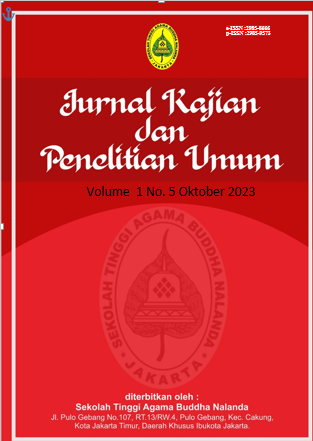Analisis Gerak Silek Pauh Di Perguruan Silaturrahmi Kelurahan Kalumbuk Kecamatan Kuranji Kota Padang
DOI:
https://doi.org/10.47861/jkpu-nalanda.v1i5.441Keywords:
Analysis, Motion, Silek Pauh, Silaturrahmi CollegeAbstract
The purpose of this study is to describe and analyze the Silek Pauh movement in Kalumbuk Village Friendship College, Padang City, Kuranji District from the perspective of space, time and energy. This research uses qualitative research with descriptive and analytical methods. This research instrument is the researcher himself and is assisted by supporting devices such as stationery, cameras and mobile phones. Daat is collected through literature study, observation, interviews and documentation. The stages of data analysis are data collection, data reduction, data modeling and data collection. The results showed that Silek Pauh has motion analysis based on space, time and energy. This can be seen in the well-constructed movements. Pauh's smooth motion mostly forms curved lines in relation to space, meaning a light, dynamic, and powerful figure. In the time aspect, Silek Pauh's movements follow the musical accompaniment played by the musician. The aspect of Silek Pauh's movement time in the results of this study is more dominant using the tempo being carried out by the martial artist. In the power aspect, it uses a lot of and medium power because the movement uses the attraction of fights between attackers and detractors using the property of a cleaver (knife).
References
Desfiarni, D. (2004). Tari Luka Gilo: Sebagai Rekaman Budaya Minangkabau Praislam: dari Magis ke Seni Pertunjukan Sekuler (pp. 1-169). Kalika.
Desfiarni, D. (2014). Tinjauan Estetika Tari Piriang Jorong Limau Sundai Pasir Talang Solok Selatan. Humanus, 12(2), 120. https://doi.org/10.24036/jh.v12i2.4032
Gunawan, Gugun Arif. (2007). Beladiri. Yogyakarta: Insan Madani
Indrayuda, Muasri, dan Sexri Budiman. (2013). Randai Suatu Aktivitas Kesenian dan Media Pendidikan Tradisional. Padang: Dinas Kebudayaan dan Pariwisata Provinsi Sumatera Barat UPTD Taman Budaya, 2013.
Jazuli, Muhammad. (2008). Pendidikan Seni Budaya Suplemen Pembelajaran Seni Tari. Semarang: Universitas Negeri Semarang Press.
Jogiyanto, H. M, (1999). Analisis dan Desain Sistem Informasi. Yogyakarta: Andi.
Kayam, Umar. (1981). Seni, Tradisi, Masyarakat. Jakarta : Sinar Harapan
Moleong, Lexy. J. (2012). Metode Penelitian Kualitatif (Edisi Revisi). Bandung: Remaja Rosdakarya.
Mulyana. (2013). Pendidikan Pencak Silat Membangun Jati Diri dan Karakter Bangsa. Bandung. PT. Remaja Rosdakarya
Murgiyanto,Sal. (1983). Seni Menata Tari. Jakarta: Dewan Kesenian
Putri, R. G., & Desfiarni, D. (2020). Pelestarian Tari Ambek-Ambek Oleh Sanggar Timbulun Koto Basaga Di Nagari Koto Anau Kecamatan Lembang Jaya Kabupaten Solok. Jurnal Sendratasik, 10(1), 227. https://doi.org/10.24036/jsu.v9i2.110550
Srirahayu, S., & Desfiarni, D. (2020). Pelestarian Tari Piriang Rantak Tapi Di Kenagarian Pitalah Kecamatan Batipuh Kabupaten Tanah Datar. Jurnal Sendratasik, 10(1), 237. https://doi.org/10.24036/jsu.v9i2.110539
Ulfa, N. a, & Desfiarni, D. (2022). Analisis Gerak Tari Rangguk Desa Seberang Kecamatan Pesisir Bukit Kota Sungai Penuh. Jurnal Sendratasik, 11, 476–485. https://doi.org/10.24036/js.v11i4.118262
Downloads
Published
How to Cite
Issue
Section
License
Copyright (c) 2023 Roja’atul Khoiriyah, Desfiarni Desfiarni

This work is licensed under a Creative Commons Attribution-ShareAlike 4.0 International License.








